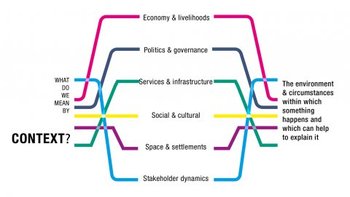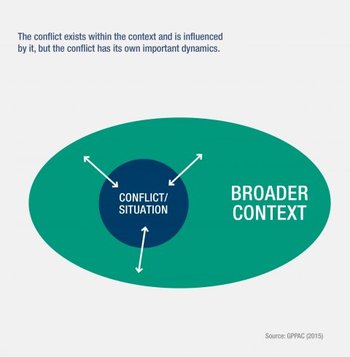Humanitarians need a variety of information in order to fully understand and effectively respond to crises - What is the impact of the crisis? Who has capacity? Where are the needs? All of these things can be more complex to understand if the crisis occurs in an urban area. While humanitarians are still working to improve their ability to understand needs and capacities in an urban disaster, there’s often another gap – humanitarian organisations do not adequately understand the context in which they are working.
ALNAP recently published a study which explores tools for understanding context. This blog summarises three things you definitely need to know, and links to further materials that explore other key findings.
- “Context” refers to all the things which make up a place – the politics and governance, economy and livelihoods, social issues and culture, infrastructure and services, space and settlements, and the range of stakeholder and networks which connect them.

Context is broader than any one situation, and can actually help to explain what is happening at a given time. Think about the culture or the economy where you live – both are constantly evolving but are not likely to just transform overnight. A crisis will undoubtedly have an impact on the context, but the context existed long before any one event and will continue long after.

2. Improving our understanding of context will improve our response – particularly in complex urban areas. Understanding context allows us to…
- design effective, relevant, evidence-based and proactive responses
- recognise and support existing networks, institutions and plans
- work effectively and appropriately with a range of urban stakeholders (and not just those we are partnering with)
- have a holistic understanding of the interconnected nature of the city we are operating in
What is urban context? Why is it so important for humanitarians to understand?
Understanding context can also help to explain how communities may respond to messaging. This can help responders find leverage to increase their potential impact and avoid exacerbating tensions. Humanitarians should endeavour to better understand the context wherever they work – but this is particularly important in urban areas due to the complexity of these environments, where the context is dynamic and interconnected, and there are a large number of different stakeholders.
However, understanding context isn’t just important for international actors. While it is vital humanitarians establish an understanding of countries they haven’t worked in before, those already familiar with a context should make understanding it an continuous process too. The majority of tools explored in ALNAP’s new research were developed by international organisations, but a number of national staff were interviewed and explained how they also found value in making use of them. In some cases, this led to new insights. At times, the information was not new but the exercise of using a tool legitimised their existing understanding. And finally, they found value in the process of creating a shared understanding of the context with colleagues.
- There are plenty of tools already available which can help you understand context.
ALNAP’s study looked at 25 different tools, and there are even more out there to explore. To get started, you can take a look at this video which introduces a handful of them. You can then take a look at the study annex to learn more about all 25 tools.
Once you’ve started looking into the tools, you’ll probably have lots of questions. ALNAP has created a number of different materials to help you at different stages:
- If this is your first foray into the world of context tools, this 8 step document can help with where and how to begin using them.
(To be more visual we could put cover pictures of some of the resources in addition to the hyperlinks) - If, instead, you are not convinced of the value of context analysis, or are having trouble convincing others? This policy brief focuses on the ‘why is this important?’ argument and might be particularly useful for organisational leadership and donors.
- You might also want to check out ’10 tips to make the most of context tools’ and a final video, both of which summarise some of the key findings from ALNAP’s study. For example should context analysis be a coordinated effort or done by each organisation individually and how do you decide scope?
Finally, you can also access the recording and transcript of the webinar ALNAP held to launch the study and related materials earlier this year.